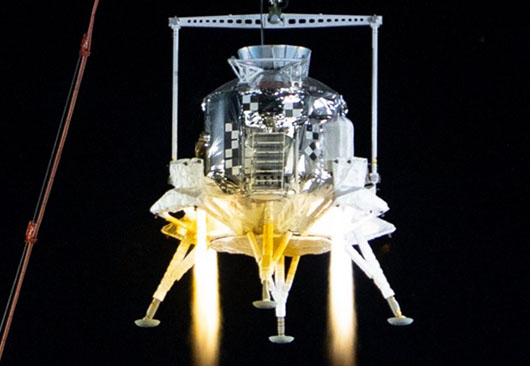Special to CosmicTribune.com, August 13, 2025
By Richard Fisher
The second race to the Moon, this time between the United States and China, saw another step in China’s favor on Aug. 6, 2025, when a full-scale powered version of China’s manned Moon lander called Lanyue (for Embracing The Moon) reportedly achieved its first powered test.

[On Aug. 4, Fox News reported that under Acting Administrator Sean Duffy, the National Aeronautics and Space Administration (NASA) was preparing to sign directives to accelerate the U.S. goal of building a small nuclear power plant to power a future U.S. Moon Base.]
Chinese state media reported the event on Aug. 7 as having occurred during the night of Aug. 6th at the Extraterrestrial Landing Test Site in Huailai County, Hebei Province, a tall structure with controlled descent cables used to simulate Moon landings for the Change series unmanned moon landers.
Additional state media images indicate that rocket engines on Lanyue were also tested in daylight, indicating the possibility of an unreported prior “dry run,” a common People’s Liberation Army (PLA practice when revealing politically important technology.
On Aug. 7 state media Xinhua reported the China Manned Space Agency stating:
“The successful trial represents a critical step in China’s manned lunar exploration project, laying the technical foundation for future moon landings. The test involved complex working conditions, a long preparation cycle and great technical challenges.”
Xinhua further reported, “The integrated test verified key systems, including the lander’s flight control strategies, landing shutdown mechanism, guidance-navigation-control systems and interface coordination between various subsystems.”
It further reported, “The trial run included emergency condition simulations, designed to test whether astronauts could be safely returned to orbit in the event of an in-flight malfunction.”
An official with Lanyue’s designer, the China Aerospace Science and Technology Corporation (CASC), commented, “We’ve designed the lander with engine redundancy, meaning even if one engine fails, the crew can still be brought back safely to lunar orbit and ultimately home.”
As the Lanyue lander employs four engines for descent and take-off from the Moon, this could indicate that Lanyue’s reduced weight after using fuel for landing is sufficient to allow lift-off to lunar orbit with only three engines.
Full Text . . . . Current Edition . . . . Subscription Information

You must be logged in to post a comment Login